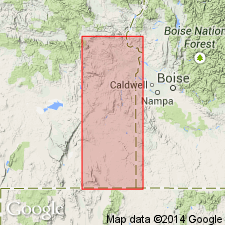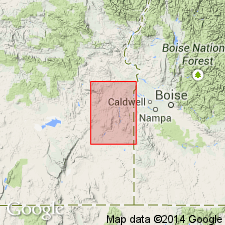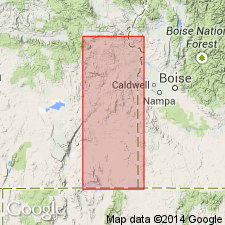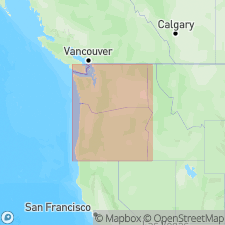
- Usage in publication:
-
- Littlefield Rhyolite
- Modifications:
-
- Named
- Dominant lithology:
-
- Rhyolite
- AAPG geologic province:
-
- Snake River basin
Summary:
Named for exposures at Littlefield ranch, sec.35 T23S R40E, Mahleur Co, OR. Consists of flaggy grayish-red or dark-gray multiple-flow porphyritic rhyolite with about 70% silica content. Conspicuously flow foliated. Thickness about 500 ft. In Crowley district overlies unnamed igneous complex. Probably unconformably underlies Butte Creek Volcanic Sandstone (new) which contains Barstovian mammalian fossils. Underlies Drip Spring Formation (new) in Harper Basin district. Overlies Hunter Creek Basalt (new) in Monument Peak, Malheur Gorge, and Harper Basin districts. Has been dissected and faulted, probably in late Miocene time and forms basin of deposition for later rocks. Is considered Miocene age.
Source: GNU records (USGS DDS-6; Menlo GNULEX).

- Usage in publication:
-
- Littlefield Rhyolite
- Modifications:
-
- Mapped
- AAPG geologic province:
-
- Snake River basin
Summary:
Shown on geologic map of Owyhee district, Malheur Co, OR. Described as multiple flows of grayish-red porphyritic, flow-foliated rhyolite with phenocrysts of plagioclase, potassium feldspar, and pyroxene. Overlies Dinner Creek Welded Ash-Flow Tuff and Hunter Creek Basalt. Underlies Drip Spring Formation and unconformably underlies Quaternary alluvium. Age is shown as Miocene.
Source: GNU records (USGS DDS-6; Menlo GNULEX).

- Usage in publication:
-
- Littlefield Rhyolite
- Modifications:
-
- Age modified
- AAPG geologic province:
-
- Snake River basin
Summary:
Age for Littlefield Rhyolite is given as late Miocene [no basis given]. On the west in Cottonwood basin, unit underlies Tims Peak Basalt (of early Pliocene age); on the east in Cottonwood basin underlies both Grassy Mountain Formation and Tims Peak Basalt. In center of basin Littlefield Rhyolite sank down forming depression which received Drip Spring Formation and Bully Creek Formation.
Source: GNU records (USGS DDS-6; Menlo GNULEX).

- Usage in publication:
-
- Littlefield Rhyolite
- Modifications:
-
- Geochronologic dating
- AAPG geologic province:
-
- Snake River basin
Summary:
Littlefield Rhyolite. Sample from Millers Cow Camp near Littlefield Ranch, in SW/4 sec. 35, T. 23 S., R. 40 E., Malheur County, Oregon. K-Ar age on plagioclase 17.5 +/-0.6 Ma.
Source: Modified from GNU records (USGS DDS-6; Menlo GNULEX).
For more information, please contact Nancy Stamm, Geologic Names Committee Secretary.
Asterisk (*) indicates published by U.S. Geological Survey authors.
"No current usage" (†) implies that a name has been abandoned or has fallen into disuse. Former usage and, if known, replacement name given in parentheses ( ).
Slash (/) indicates name conflicts with nomenclatural guidelines (CSN, 1933; ACSN, 1961, 1970; NACSN, 1983, 2005, 2021). May be explained within brackets ([ ]).

